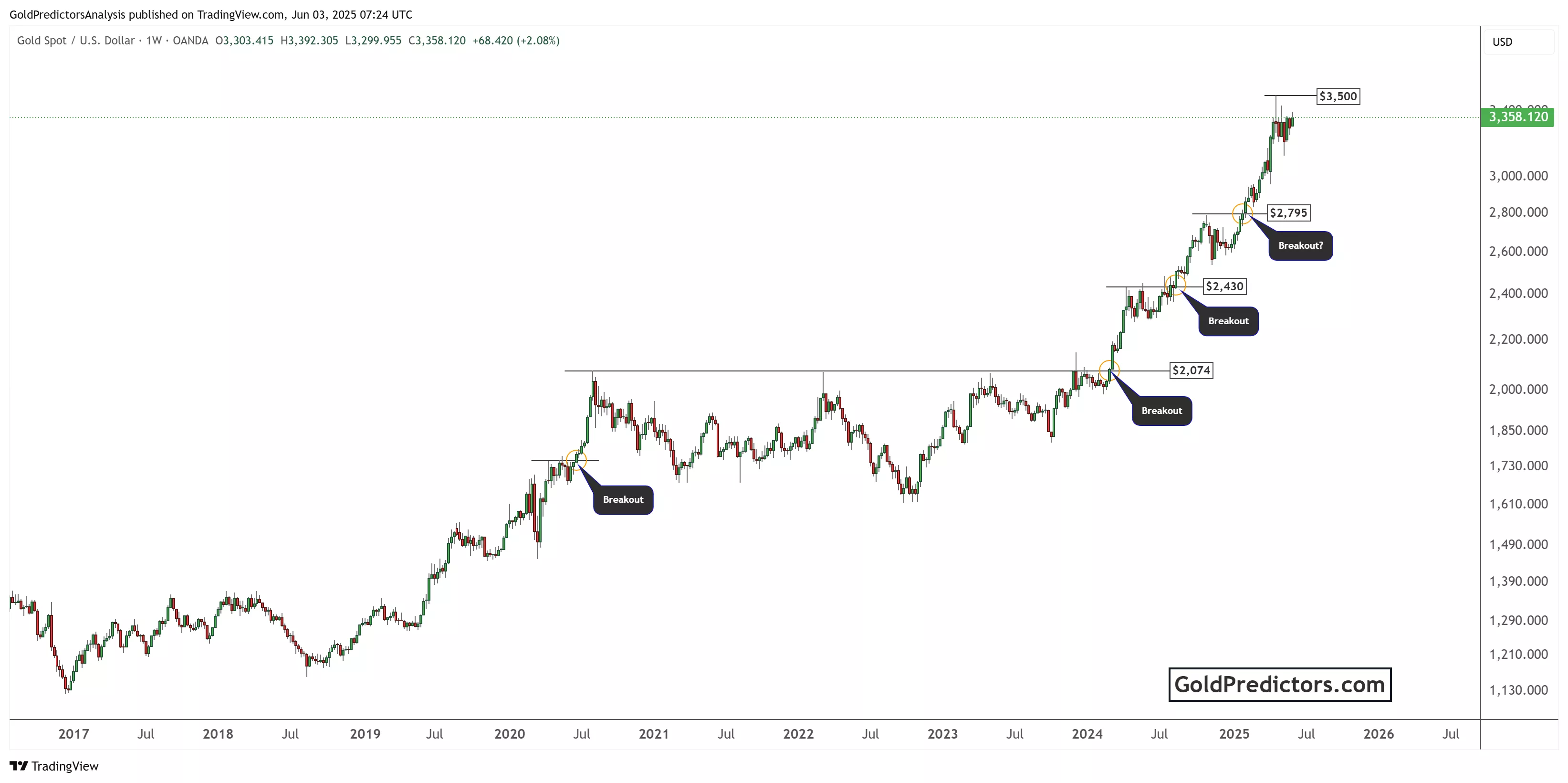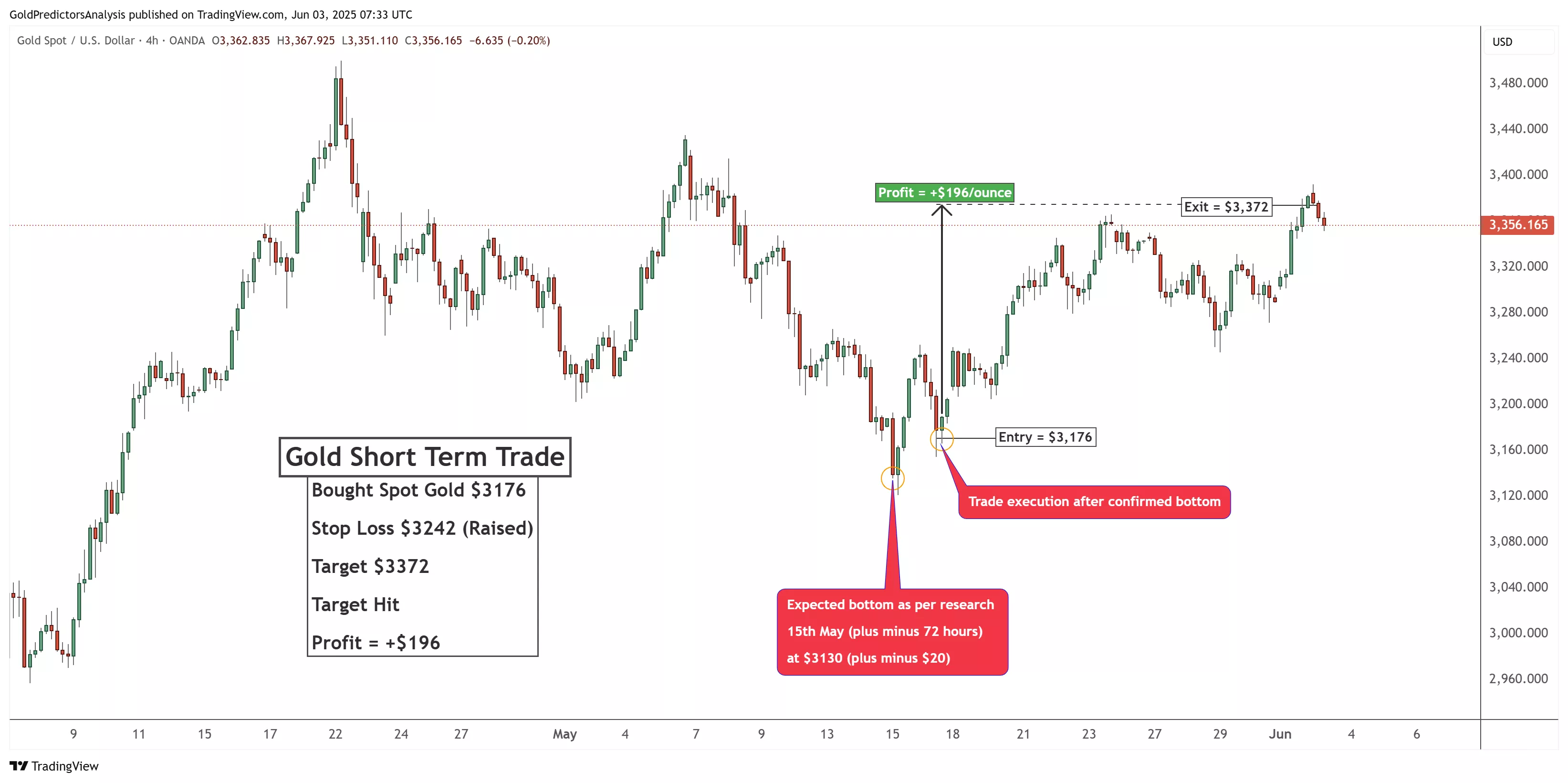Gold Surges On Weak U.S. Data, Fiscal Worries, And Bullish Breakouts

Photo by Dmitry Demidko on Unsplash
Gold is gaining momentum as investors respond to weakening U.S. economic data, falling bond yields, and rising fiscal concerns. Job growth is slowing, services activity is contracting, and markets now expect rate cuts later in 2025. Yields are dropping, making non-yielding assets, such as gold, more attractive. At the same time, widening deficits and a softer U.S. dollar are fueling demand. Trade tensions and geopolitical risks add to the uncertainty. In this environment, gold is emerging as a preferred haven.
Weak US Economy and Declining Yields Drive Gold Demand
The macroeconomic environment currently supports gold as a defensive asset. Recent US economic data shows clear signs of weakening. The ADP report revealed that only 37,000 private-sector jobs were added in May, well below expectations. At the same time, the ISM Services PMI dropped to 49.9, signaling contraction for the first time in nearly a year. These indicators have strengthened market expectations that the Federal Reserve will begin cutting interest rates later in 2025. Bond yields have already responded, with 2-year and 10-year Treasury yields falling to their lowest levels since early May. As yields decline, the appeal of non-yielding assets, such as gold, increases.
Fiscal concerns in the US are further fueling bullish sentiment for gold. President Trump’s new tax and spending policies are expected to widen the budget deficit. This has weakened confidence in the US Dollar, which generally moves inversely to gold. As the dollar softens, gold becomes more attractive to investors. Meanwhile, trade tensions are rising again. The US has doubled tariffs on steel and aluminum imports from China, reviving fears of a renewed trade war. An upcoming call between President Trump and Chinese President Xi Jinping is also adding to global uncertainty, another factor that typically boosts demand for gold.
Geopolitical risks are also playing a crucial role in supporting gold prices. The situation in Gaza continues to escalate, with renewed Israeli strikes and a deepening humanitarian crisis. Tensions in Eastern Europe are intensifying as well, especially following President Trump’s remarks about possible Russian retaliation against Ukraine. These global flashpoints are maintaining a substantial geopolitical risk premium in the market. In summary, gold is benefiting from a powerful combination of weak US economic data, dovish Fed policy expectations, fiscal instability, rising trade tensions, and global geopolitical uncertainty.
Gold Price Breakouts Signal Strength and Set Up for Next Rally
The gold chart below shows a series of bullish breakout patterns that have occurred over the past few years. The price action has consistently broken through key resistance levels, followed by strong upward moves. The first major breakout occurred around mid-2019 near the $1,350 level. After consolidation, gold surged to test the $2,074 zone in 2020. A prolonged range followed until a decisive breakout in late 2023, clearing that previous high and pushing to $2,430.
(Click on image to enlarge)

Subsequent price action has shown clean, stair-stepping advances, with each breakout zone turning into new support. This includes the break above $2,430, followed by a fresh rally to $2,795 and then to the current high near $3,358. The chart suggests a potential target of $3,500 in the near term. Candlestick formations remain bullish, and no major reversal signals have appeared. The trend remains intact. The only caution is the label "Breakout?" near the $2,795 level, indicating the market might retest this zone before further gains.
Momentum is strong, and as long as gold holds above previous breakout zones, especially $2,430 and $2,795, the path of least resistance remains to the upside. A failure below those levels, however, could suggest a temporary top is in place.
Gold Trading Strategy Delivers Profits with Clear Entry and Exit Points
The chart below shows a successful short-term gold trade executed based on a well-defined technical setup, featuring clear entry, stop-loss, and target levels that yielded a profitable outcome. The trade was entered at $3,176 after the price confirmed a bottom near the expected reversal date. A stop loss was initially placed below the low but later raised to $3,242 to protect profits as the trade moved favorably. The target was set at $3,372, which was eventually hit, resulting in a total gain of $196 per ounce. The chart clearly shows the entry point, the upward movement, and the exit level, validating the effectiveness of the timing and risk management strategy. This trade was shared with subscribers via WhatsApp, offering a real-time, actionable opportunity that delivered a defined and measurable profit.
(Click on image to enlarge)

Conclusion
Gold remains well-supported as investors navigate a turbulent global environment. Weak US data, expectations of Fed rate cuts, fiscal concerns, trade tensions, and geopolitical risks continue to drive demand. Technical signals confirm strong bullish momentum, with prices holding above key breakout zones. As long as these levels remain intact, the outlook favors further upside. Traders now await clearer signals, especially from the upcoming NFP report, to confirm the next move.
More By This Author:
Gold Remains Resilient As Traders Monitor U.S.-China Trade Talks And Fed Signals
Gold Price Holds Above Key Support Despite Dollar Strength And Policy Uncertainty
Gold Maintains Bullish Momentum Amid Court Ruling On Tariffs And Weakening U.S. Dollar
To receive gold and silver trading signals and premium updates, please subscribe here.
Disclosure: Materials distributed by ...
more


